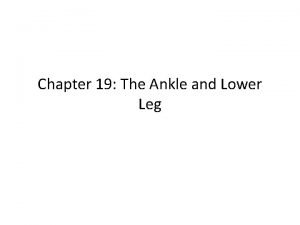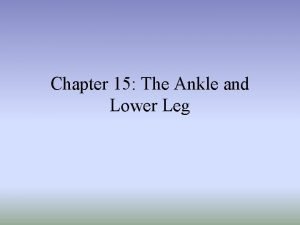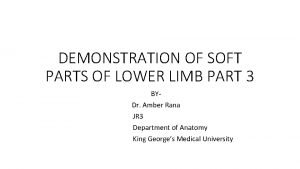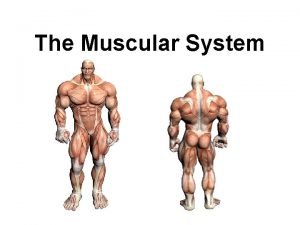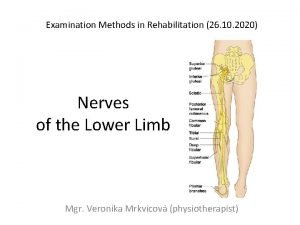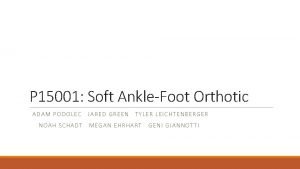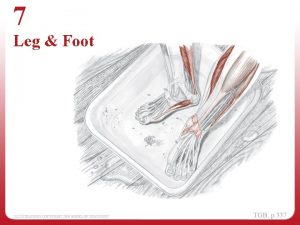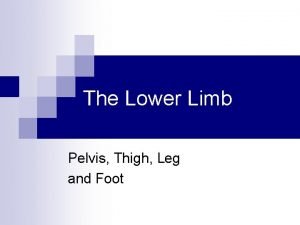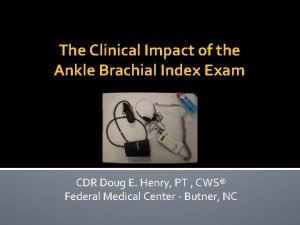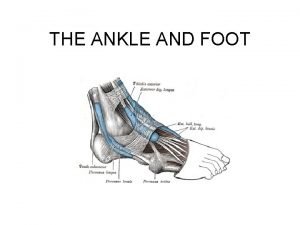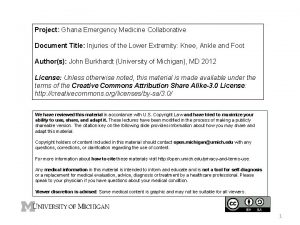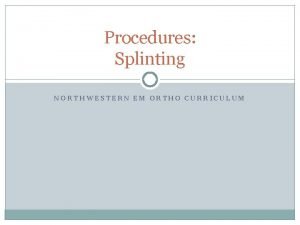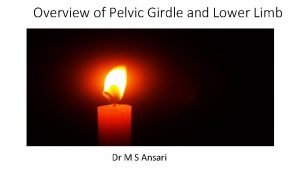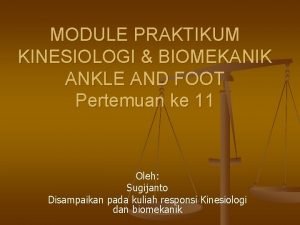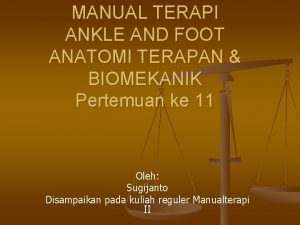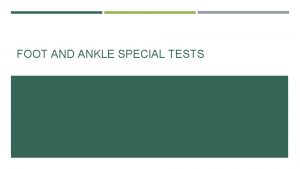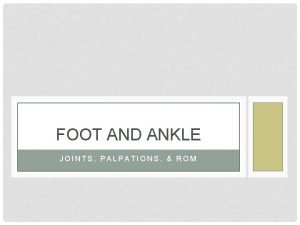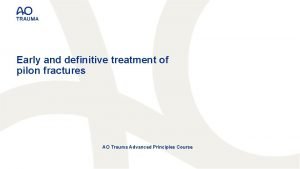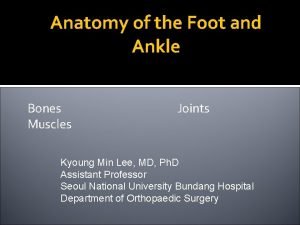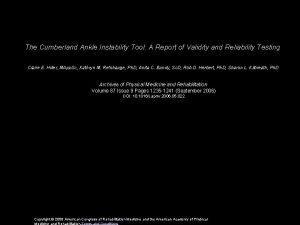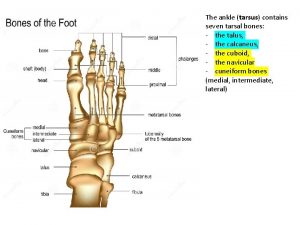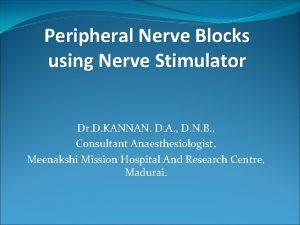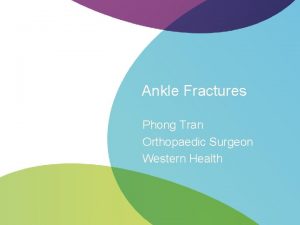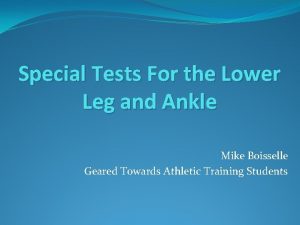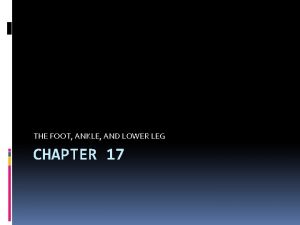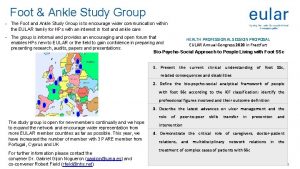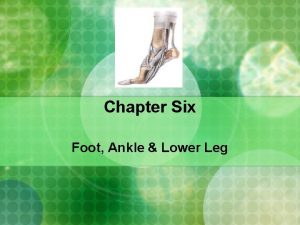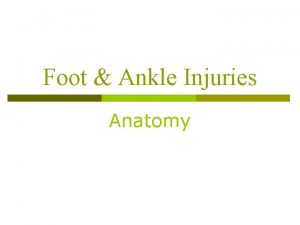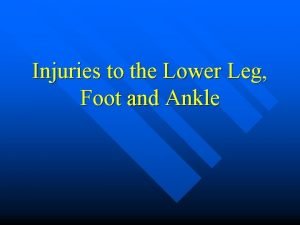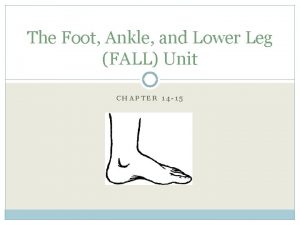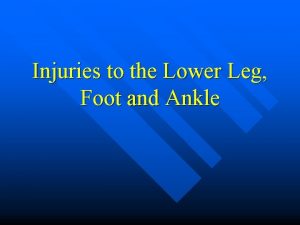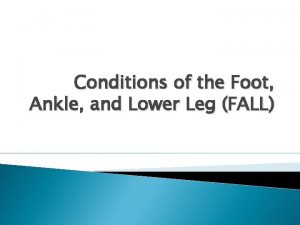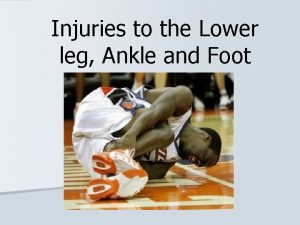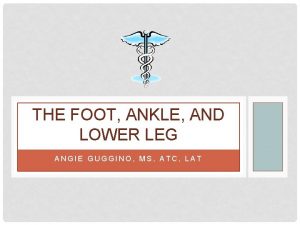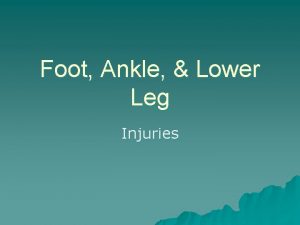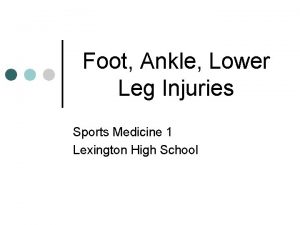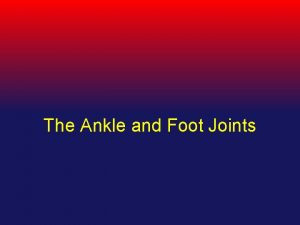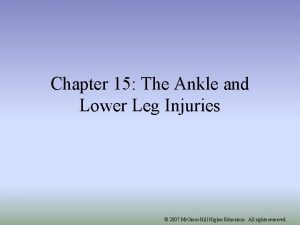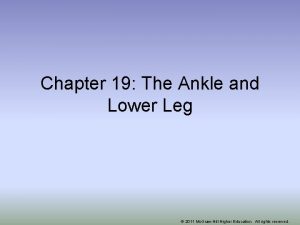CHAPTER 15 FOOT ANKLE AND LOWER LEG FOOT








































- Slides: 40

CHAPTER 15 – FOOT, ANKLE AND LOWER LEG

FOOT ANATOMY

FOOT ANATOMY It is complex! 26 bones 33 joints Over 100 muscles, tendons and ligaments

ANATOMY - BONES PHALANGES (Toes) – 14 Big toe has two phalanges, the rest of the toes have three Proximal, middle, and distal

FOOT ANATOMY - BONES METATARSALS – 5 1 ST one is medial and 5 th one is lateral

FOOT ANATOMY – 26 BONES TARSAL BONES – 7 Calcaneus – heel bone Talus – forms the ankle Navicular – medial in respect to the talus Cuboid - lateral Cuneiforms (3)

FOOT ANATOMY PLANTAR FASCIA Broad, flat tendonous structure that runs on the undersurface of the foot Starts on the calcaneus and inserts onto the heads of the metatarsals Supports the arch of the foot

FOOT ANATOMY - ARCHES Support body weight and absorb shock There are four arches: MEDIAL LONGITUDINAL ARCH LATERAL LONGITUDINAL ARCH METATARSAL ARCH TRANSVERSE ARCH

FOOT - MOTIONS Toes Flexion and Extension Foot Pronation – like fallen arch Supination – high arch

ANKLE ANATOMY - BONES Two bones in the lower leg Tibia – medial, larger, weight bearing Medial Malleolus Fibula Lateral Malleolus Two tarsal bone Talus Calcaneus

ANKLE ANATOMY - JOINTS TRUE ANKLE JOINT Tibia, fibula and talus Mortise Definition: where the talus fits into the tibia and the fibula

ANKLE ANATOMY - JOINTS Subtalar joint Between the Talus and the Calcaneus

ANKLE ANATOMY - LIGAMENTS LATERAL – 3 ligaments named for bones Anterior talofibular (ATF) Calcaneofibular (CF) Posterior talofibular (PTF)

ANKLE ANATOMY - LIGAMENTS MEDIAL Deltoid Strong ligament 4 parts that form one ligament

ANKLE ANATOMY - LIGAMENTS TIBIOFIBULAR LIGAMENTS – holds tibia and fibula together Anterior tibiofibular Posterior tibiofibular

ANKLE MOTIONS Dorsiflexion Plantarflexion Inversion Eversion

LOWER LEG ANATOMY Bones Tibia Fibula

LOWER LEG MUSCLES The muscles are in four compartments with 2 -4 muscles in each compartment Compartments are held together by fascia

LOWER LEG MUSCLE COMPARTMENTS 1. LATERAL – everts the ankle 2. ANTERIOR – dorsiflexes the ankle 3. DEEP POSTERIOR – plantarflexes the ankle (the calf muscle) 4. POSTERIOR MEDIAL – inverts and plantarflexes the ankle

LOWER LEG - Major Muscles and Actions Anterior Tibialis - dorsiflexor Peroneals - evertors Gastrocnemius – plantarflexor Soleus – plantarflexor Posterior Tibialis – invertor

INJURIES

PLANTAR FASCIITIS Common with athletes who are on toes and/or have high arches Causes: Not enough arch support in shoes, tight calf muscle Signs/Symptoms: Sharp pain occurs in the heel to mid-foot, especially with dorsiflexion Hurts in the morning, feels better as they warm up Treatment: Gentle stretches, roll on tennis ball or frozen can, arch taping or orthotics.

JONES FRACTURE Fracture of the base of the 5 th metatarsal Causes: inversion; rotational forces; overuse S/S: Feel and hear a ‘pop’; pain in the lateral foot over 5 th metatarsal, swelling, inability to walk Tx: immobilization (cast) 6 -8 weeks or longer, often requires surgery

BUNIONS (HALLUX VALGUS) Deformity of the head of the 1 st metatarsal/big toe Can have bunion on 5 th metatarsal/toe too Cause: extra bone is laid down on head of 1 st metatarsal – poor shoes, genetics, on toes Great toe and 1 st Metatarsal become malaligned S/S: Pain, swelling and deformity of big toe joint, shoes are painful Treatment: Proper shoes; doughnut pad over the bunion; surgery

TURF TOE Great Toe sprain Cause: Hyperextension of the big toe at the metatarsal phalangeal joint; kicking something Common on artificial turf b/c turf shoes allow more motion S/S: swelling and pain in the MTP joint, pain with hyperextension (pushing off toe) Tx: RICE, rigid insoles or toe boxes, taping to prevent hyperextension of toe

INGROWN TOENAILS Cause: leading side of toenail grows into skin, usually results in infection and pain May trim nails too short or ill-fitting shoes S/S: Inflammed and red nail bed at corner of toenail, may have drainage/pus Tx: May need to refer to doctor; soak in betadine bath; pack cotton under toenail, surgical shaping of toenail

PUBLIC SERVICE ANNOUNCEMENT HIGH HEELS Loads 5 times your body weight onto your heel Overloads forefoot Deforms the arch Reduces shock absorption Plantar fasciitis Leads to inflamed nerves in your toes Morton’s Neuroma Shortens your calf Achilles tendinitis Changes your center of gravity – more forward Have to extend back to compensate

TYPES OF ANKLE SPRAINS Inversion Most common type of ankle sprain Accounts for 80% of all sprains AKA ‘a lateral ankle sprain’ First degree sprain Only involves the anterior talofibular ligament Mild pain, tenderness, and swelling No instability Out 1 -2 weeks

TYPES OF ANKLE SPRAINS Inversion Second degree sprain Anterior talofibular ligament is torn and calcaneofibular ligament is injured as well Most painful Moderate swelling Discoloration Hears/feels a pop Mild Instability Out 4 -6 weeks

TYPES OF ANKLE SPRAINS Inversion Third degree sprain Complete tear of all three lateral ligaments Uncommon Feel and hear multiple pops Lots of pain, but it can subside Significant swelling Very unstable Usually requires surgery

ANKLE SPRAIN TREATMENT Prevention Exercises Rest No activity Ice 20 minutes on, 40 minutes to an hour off No heat Compression – Ace Wrap Elevation – above heart Support Crutches, braces

TYPES OF ANKLE SPRAINS Eversion Not as common Can occur more on tartan surfaces and artificial turf Everything is worse (pain, swelling, etc) when compared to an inversion injury If the deltoid tears, the tibiofibular ligaments may tear also

HIGH ANKLE SPRAIN Involves Anterior Inferior Tibiofibular (AITFL) Ligament Injury allows tibia and fibula to separate

HIGH ANKLE SPRAIN Cause: Inversion with rotation; rotation of foot S/S: pain with external rotation of foot; tender over AITFL, swelling, does not want to weight bear Treatment: RICE, may need to be immobilized; possible surgery if severe enough

TIBIA/FIBULA FRACTURES Always need to suspect a fracture when evaluating a potential sprained ankle Cause: Too much motion S/S: immediate swelling, point tender over the malleoli, deformity, does not want to weight bear Treatment: splint, ice, x-ray weeks Cast 6 -8

MEDIAL TIBIAL STRESS SYNDROME ‘SHIN SPLINTS’ Occurs in distal 2/3 of posterior/medial tibia Causes: pronation, lack of flexibility in the lower legs, hard surfaces, hills, muscle weakness, poor shoes, increasing running distance too quickly S/S: resisted plantar flexion and inversion should hurt, pain is just off the tibia, achy or sharp pain Treatment : prevention (shoes, arch support), strengthening, stretching, ice massage, contrast bath, tape arches Refer to MD if no improvement to rule out stress fracture

COMPARTMENT SYNDROME Occurs when pressure increases in compartment and shuts off blood and nerve supply to the foot Most often occurs in the anterior and deep posterior compartment THREE TYPES Acute Exertional Chronic

ACUTE COMPARTMENT SYNDROME Medical emergency Causes: direct blow to the lower leg Usually in the anterior lower leg Symptoms come about several hours later S/S: compartment is tense, warm, red and shiny; complains of (c/o) deep aching pain; circulation and sensory problems in foot Tx: ice, elevation – refer to ER immediately

ACUTE EXERTIONAL/CHRONIC COMPARTMENT SYNDROME Cause: running and jumping activities S/S: With activity, foot goes to sleep, crampy pain, and tingling. When activity stops, it goes away. Consistent as to when it comes on with activity Tx: ice, activity modification, stretching, massage, and referral to the doctor (possible surgery)

ACHILLES TENDINITIS Chronic, overuse condition that comes about gradually Causes: running and jumping, repetitive stress, running up hills, poor flexibility S/S: achy type pain in Achilles, Achilles is tender on palpation, pain with standing plantarflexion, may have crepitus, hurts to warm up and to cool down TREATMENT If there is crepitus, no running for 1 -2 weeks Stretch! Heel lift in both shoes Orthodics Heat and/or ice
 Chapter 19 worksheet the ankle and lower leg
Chapter 19 worksheet the ankle and lower leg Chapter 15 worksheet the ankle and lower leg
Chapter 15 worksheet the ankle and lower leg Saa congruence theorem
Saa congruence theorem Anatomy and physiology of the foot
Anatomy and physiology of the foot Medial marginal vein
Medial marginal vein Parts of lower leg
Parts of lower leg Lower extremity pulses
Lower extremity pulses Adducts arm
Adducts arm Anterior muscles of the leg
Anterior muscles of the leg Lymph nodes in legs
Lymph nodes in legs Lower leg nerve
Lower leg nerve Ankle foot orthoses
Ankle foot orthoses Foot orthosis design challenge
Foot orthosis design challenge Leg
Leg Sacral plexus
Sacral plexus You put your right foot in
You put your right foot in Kind of triangle
Kind of triangle Calculating abi
Calculating abi Ankle eversion
Ankle eversion Tibialis muscle function
Tibialis muscle function Hip range of motion
Hip range of motion Ottawa criteria
Ottawa criteria Buddy splint
Buddy splint Regio ankle
Regio ankle Abi index normal
Abi index normal Sacral plexus
Sacral plexus Biomekanik ankle
Biomekanik ankle Mtp 1 anatomi
Mtp 1 anatomi Ankle special test
Ankle special test Rom toes
Rom toes Chaput fragment ankle
Chaput fragment ankle Gastrocenimus
Gastrocenimus The cumberland ankle instability tool
The cumberland ankle instability tool Seven ankle bones
Seven ankle bones Perpneal tendon
Perpneal tendon Ankle pull
Ankle pull Dorsum leg
Dorsum leg Ankle joint anatomy
Ankle joint anatomy Dime sign ankle
Dime sign ankle Homan sign
Homan sign Offred tattoo ankle
Offred tattoo ankle
